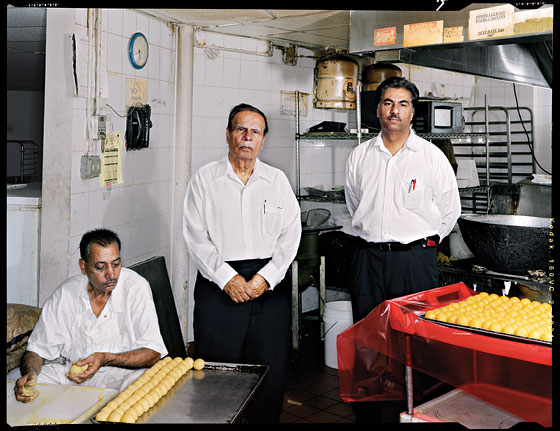 |
Abdul Hamid and his son Tariq (right), with one of their chefs in the kitchen of Shaheen Sweets in Jackson Heights.
(Photo: Dan Winters) |
One day in 1968, Abdul Hamid walked into the U.S. Consulate in Lahore, Pakistan, hoping to obtain a visa. He was 40 years old, had five children, and had never been to America before. His black-and-white passport photo shows an unsmiling man with dark hair and a thin mustache; his height is recorded as five-five. At the time, very few Indians, and even fewer Pakistanis, were immigrating to America, and those who did were usually students or professionals, with titles like doctor or engineer. Abdul’s education had ended in the seventh grade, after his mother died and he went to work in his father’s sweets shop.
He didn’t know what he would do to make a living in America, but he knew he needed to get out of Pakistan. Disputes over a pharmacy he ran with a relative had soured him on the business. And the threat of religious persecution was looming; several years later, many members of his Islamic sect would be killed. A nephew enrolled in graduate school in New York urged him to immigrate. The land of opportunity, he said, was a place called Queens.
The INS admitted 67,943 immigrants to New York City that year. Nearly 25,000 came from the Caribbean: Jamaica, the Dominican Republic, Haiti, Trinidad, Cuba. Others arrived in large numbers from Italy, Greece, China, Yugoslavia, and Colombia. Only 507 came from India, even fewer from Pakistan. At the time, New York’s Indian population numbered no more than a few thousand. There was no Little India in Jackson Heights, no Curry Hill by Lexington and 28th Street.
When Abdul first arrived, he stayed with his nephew in a mosque on Archer Avenue in Jamaica, sleeping on the floor of the prayer room. His nephew was his sole source of companionship; the two spoke Urdu to each other, but Abdul, who knew little English, had no one else to talk to. With his nephew’s help, he got a job as a dishwasher in a restaurant at Kennedy airport. The pay was $45 a week. Some days he was told to clean the toilets, too, though at first he wasn’t sure how since the toilets were so different from those back home.
He worked his way up to busboy, and within a year he had a job as a security guard at the airport. In the fall of 1970, he borrowed money from a friend in Pakistan to bring over his family: his wife and their children, four boys and a girl, ages 7 to 16. They joined him in Richmond Hill, where he had moved into an apartment with his nephew and his nephew’s family. With eleven people squeezed into two bedrooms, the children slept on the floor.
“The first five years was the toughest time of our life,” says Abdul’s oldest son, Salam. “There were many times we asked our father that we should go back, but he was so determined. He said, ‘Listen. Now we are here, and we have no way of going back.’ ” Salam thought he knew where his father’s determination came from: “He had seen another migration before,” he says, “so he knew how to handle the situation.” Abdul was born to a Muslim family in India and had moved to Pakistan following Partition in 1947. Carrying all his belongings in a single sack, he’d made the trip by himself at age 19. “It was a matter of survival,” Salam says.
Now in another foreign land, Abdul was determined to do more than survive. His zeal would propel the family forward over the next four decades, as their fortunes soared and plunged and then began to climb once again.
It was in the tiny kitchen of the family’s home in Queens that Abdul decided, in 1972, to try to start a business. Though he lacked a formal education, he had one skill he thought he could capitalize on: He had learned from his father how to make sweets. In India and Pakistan, sweets are everywhere—sold on street corners, eaten as snacks, presented as gifts—but there was no place to buy them in New York. At the time, the family was living in half of a two-family house in Elmhurst, and Abdul was working two jobs: nights as a watchman at Chase Manhattan Bank and days at the McDonald’s across the street from their house. After scraping together $100 from his paychecks, he bought a candy oven and started cooking ladoos—large sweet balls made of chickpea flour mixed with sugar syrup. The smell of frying oil filled every room of the house.
The first customer was a childhood friend of Abdul’s who had also migrated to New York. He picked up his sweets at the Hamids’ house, and soon the family was getting calls for more. For a homesick immigrant, there was something irresistible about the intensely sweet sensation of a ladoo crumbling in your mouth. The business soon expanded to include samosas as well as sweets. Word spread to Columbia University, where Indian students became regular customers. And each week Salam took the subway to Manhattan to drop off paper bags of sweets at two Indian grocery stores near Lexington and 29th Street.

